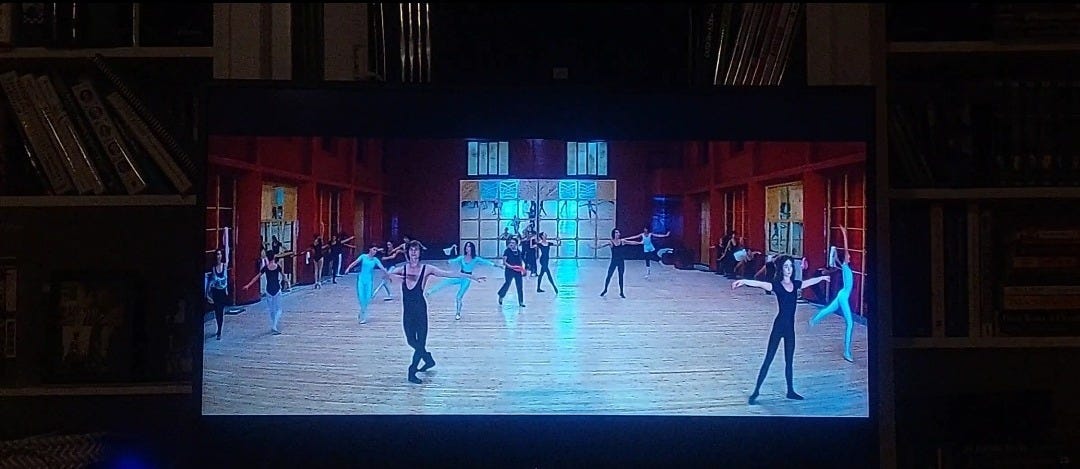“Start on one with the music,” Tilda Swinton’s character says before one of the goriest scenes in Suspiria (2018), where a dancer’s body is destroyed in a locked dance studio full of mirrors.
Director Luca Guadagnino and cinematographer Sayombhu Mukdeeprom demonstrate a piece of technical mastery here—filming mirrors without showing the camera in the mirrors. Difficult and beautiful mirror shots appear in both film versions of Suspiria. In the 1977 film, director Dario Argento and cinematographer Luciano Tovoli show off with this expansive shot of a dance studio:
The Suspiria films vary widely in color scheme and script, but both the 1977 and 2018 films utilize mirrors as an important part of dance studio set pieces and of filmmaking. Both films are also loosely based on Thomas De Quincey’s 1821 essay “Levana and Our Ladies of Sorrow.” He writes: “They wheeled in mazes; I spelled the steps. They telegraphed from afar; I read the signals. They conspired together; and on the mirrors of darkness my eye traced the plots. Theirs were the symbols; mine are the words.” Mirrors of darkness can be thought about in terms of reflecting the absence of light, and what is being hidden in the mirror (while the plot can be seen). In the Suspiria films, the camera is obscured to allow the viewer to focus on the plot and characters. And the camera’s absence is meant to awe the audience in terms of filmmaking. Thomas De Quincey’s quote can also be thought of in terms of dance—the wheeling and steps, that is the quality of movement and the choreography, are symbolic. Thomas records and interprets the symbols created in dance, like a cinematographer and director.
Suspiria (1977) is a film about filmmaking more than it is a film about dance or witches. It has many stunning shots, with and without mirrors. For instance, merch for Argento’s Suspiria includes many images of the famous stained glass window. The glass of this window can be connected to the glass in mirrors; many windows are reflective enough that cinematographers have to treat them as they would treat mirrors in the shot. However, staining the glass can make it less reflective and easier to shoot. Argento uses the colors and patterns of the stained glass as a reflection of the colors and patterns of the rest of the gorgeous sets. Then, this window is shattered during the gruesome death of a dancer, Patricia Hingle, which is the first (but certainly not the last) murder of the film.
This death can be compared to the death of the dancer Olga in Guadagnino’s version of Suspiria. In his film, Patricia Hingle disappears before the main character Susie Bannion arrives. So, in the 2018 version, Olga—not Patricia—is the first dancer to die on screen. Her death scene takes the place of Patricia’s death scene; mirrors replace stained glass. With this change, the first murder in Guadagnino’s film is a more technically difficult sequence to shoot. The murder is also far more elaborate, requiring more special effects, with Susie’s dancing in another studio seeming to function as her puppeteering the destruction of Olga’s body. This supernatural element makes the 2018 death less realistic than the stabbing and strangling of Patricia in Argento’s film. But Guadagnino uses a more realistic color palette and attempts to make the gory details seem real, despite their fantastical origin in witchcraft. Argento’s movie has incredibly unrealistic blood, made of a bright color that reflects the other bright colors he uses in the film.
In dance, the absence of mirrors often indicates a mastery of technique (and memorization of choreography). Choreographers and teachers will have dancers face away from the mirrors in the final rehearsals before a performance. This shows if they know the steps or if they are just mimicking what they see in the mirrors. Without mirrors, the dancer has to rely on her prioperspection—she has to gauge where she is in relation to the objects/people around her. She has to know the movements and steps by how they feel, not how they look in a visual aid. And she has to reproduce what she has honed in the mirror without it.
Training aerial dance (on a spinning pole) is the first time I’ve preferred working without a mirror. I instead film my dancing and watch it back on my phone. This filmic preference is due, in part, to the potential of getting dizzy while trying to look in a mirror while spinning, and also due to not having mirrors large enough to see the full height of the pole and as far as my (short) body can extend from the pole (in, say, splits). Mirrors for pole studios are extremely expensive, and some studios don’t have mirrors that reach as high as their poles reach. Generally speaking, pole dancing at home is much cheaper than pole dancing in a studio, and dancers who choose this option often aren’t going to have the funds to install huge mirrors.
But I also prefer the tactile experience of being fully in my body while I dance aerially. A mirror (and my filmed dances) will lead me to critique my form, my movements, my bunhead, etc. But taking away the mirror makes me feel more creative and free when eight feet off the floor. I’m in a space of mindfulness and focusing on the flow. I can turn off my perfectionism until I watch back my videos.




